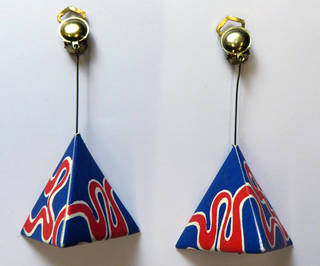From a floppy black hat to 'Space Age' boots, 1960s fashion accessories played a key role in creating the ultra-modern look. Our top-to-toe guide features iconic pieces by the decade's leading designers.
Hat by Edward Mann
This wide-brimmed woman's hat in black felt is by high-fashion London milliner Edward Mann, who designed hats for Emma Peel, Diana Rigg's character in the cult 60s spy drama The Avengers. In the first half of the 20th century hats had been an everyday item of dress. But by the 1960s, especially for young people, they became a means of extending the impact of an outfit, rather than a badge of respectability. Earlier in the decade, women's hat styles – including the popular 'bucket cloche' and the 'baker boy' cap – were influenced by Mod fashion, but towards its close, styles began to grow bigger and less structured. Popular towards the end of the 1960s, the kind of 'floppy hat' that Mann designed created a soft frame for the face, and was influenced by the hippie culture that began to steer the direction of mainstream taste.

Glasses and sunglasses by Oliver Goldsmith
Leading eyewear company Oliver Goldsmith was one of the first to recognise the fashion potential of glasses and sunglasses. They supplied eyewear to most of the decade's cultural icons, including Audrey Hepburn, Michael Caine, Jackie Onassis and Peter Sellars; their sunglasses were also the first to appear in the pages of Vogue. At the beginning of the 1960s, the popularity of stand-out eyewear was well established, having been influenced by the glamour of Marilyn Monroe, Elizabeth Taylor, Grace Kelly and other Hollywood stars wearing 'shades'. What changed in the following decade was how big and bold frames became – Oliver Goldsmith's 'TV set' and 'giant O' designs were a memorable expression of the 1960s' love affair with exaggerated Modernism. Oliver Goldsmith courted publicity by creating deliberately more unusual frames, but the firm could also design for the mass market: its chunky RIP frame became one of the decade's bestselling looks.



Jewellery by Wendy Ramshaw and David Watkins
Jewellery designers Wendy Ramshaw and David Watkins made their first technically innovative pieces in the 1960s. Their idiosyncratic work suited the times: in the early 1960s, the often rather formal stone-set jewellery on offer in the first half of the century began to be superseded by a wide variety of styles, many made from plastic. Combining backgrounds in industrial design and fine art, Ramshaw and Watkins were well placed to exploit this new landscape. Married in 1962 after they met at Reading University, the pair collaborated on their first project the following year: 'Optik', a series of bold, Op Art-inspired pieces made from screen-printed Perspex.




Handbag by Sally Jess
British bag designer Sally Jess was known for creating resolutely modern pieces, like her handbag made from silver PVC and perspex. Designed in 1966, the silver-PVC handbag illustrates a number of key mid-decade trends: exaggerated form, a bold use of new materials, Mod-inspired simplicity and, via its eye-catching silver, Space Age futurism. This kind of fun, affordable bag presented an easy way for young women to assert their independence from their mothers, who would have been likely to choose a classic snap-close leather handbag as an investment piece.

With a background in sculpture, Jess was interested in exploring form in her bags – in particular, large, quirky handles became a signature. She was the main supplier of bags to Marion Foale and Sally Tuffin, whose off-Carnaby Street store was a key address on the 'Swinging London' scene. Jess could also offer customers the thrill of a celebrity connection, being the sister of Mick Fleetwood, the drummer of rising rock band Fleetwood Mac.

Tights by Mary Quant
Quant is recognised as the first designer to commercialise tights, which were an entirely new product in the fashion industry at the time. Tights designed by Mary Quant were one of the first items produced under licence using the designer's name. For Quant, tights were a means of facilitating the super-short skirted designs that were helping make her name. Although stockings had been produced in extra-long lengths in the early 1960s, even these weren't long enough to conceal the wearer's stocking tops when sporting a 'mini' dress or skirt. Quant commissioned suppliers of theatrical costumes to make opaque woven tights in the same colours as her mini skirts and dresses, helping fuel a general explosion in public enthusiasm for this new accessory. Quant is also credited with popularising patterned tights, with her eye-catching Op Art designs.
Boots by André Courrèges
Made in 1965, these pure-white leather ankle boots were designed by French designer André Courrèges. Courrèges had launched his 'Space Age' collection the previous year – with a focus on minimal, boldly futuristic shapes – which had a profound influence on the general direction of 1960s style.

Courrèges's ideas were widely copied for the mass market; a version of his white boots became essential for women who were keen to copy the 'moon girl' look. They represented a new, more energetic feminine dress code inspired by the practicality of sportswear – unlike a lot of footwear at the time, flat boots allowed their wearers to run if they chose to. The design of these white leather boots is typical of Courrèges's work: simple, subtly avant-garde and illustrating a quietly technical use of materials (before studying fashion, Courrèges had trained as an engineer, and then learned superior cutting skills during a ten-year stint working for Cristóbal Balenciaga).


